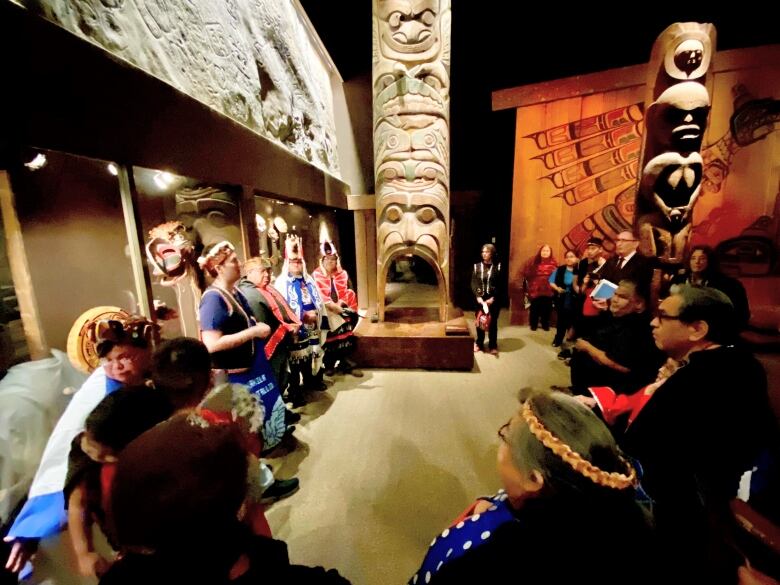Hugs, smiles and tears greet Nuxalk totem pole as it leaves Victoria museum
'My family is happy, our ancestors are rejoicing,' said Hereditary Chief Snuxyaltwa

Members of the Nuxalk Nation gathered outside the Royal B.C. Museum in downtown Victoria on Monday to greet one of their totem poles, which was taken from a village on the central coast more than a century ago.
Some members drummed and sang, one woman walked through the crowd smudging, while others stood with their eyes fixed on the top of the building as a crane extracted the pole through a hole made especially for the removal.
They cheered as the pole, which is just over five metres high and a metre wide, was lowered to the ground.
It was the first step in the repatriation of the pole, which will be taken by truck to Bella Coola later this week.
WATCH | Ceremony and dance mark start of Nuxalk totem pole's journey home:
"There is a really warm feeling in my heart," said Mara Pootlass, who has family connections to the pole. "I wanted to cry for joy because I could feel the spirit."
After family and community members took a moment with the pole, it was lifted by crane and placed beside the Mungo Martin Longhouse, adjacent to the museum.

A group of women then reawakened the pole by singing and touching it with handfuls of small feathers.
The longhouse, which is called Wawadit'ła and belongs to the Kwakiutl First Nation of Fort Rupert on north Vancouver Island, is offered to any nation wanting to hold ceremony in Victoria — with the blessing of the Songhees and Esquimalt people, whose traditional territory includes Victoria.
Two days of ceremony are underway before a convoy escorts the pole back to Nuxalk territory.
The more than 1,000-kilometre trip from the island to the mainland and up through the Interior is expected to take two or three days, depending on weather conditions.
Tap on the map below to see details about the pole's journey home:
According to Hereditary Chief Snuxyaltwa (Deric Snow), who is leading the ceremony, the pole was carved by his great-grandfather, the late Louie Snow and former owner of the Snuxyaltwa title, in the 19th or early 20th century. It was placed outside the family longhouse in Talleomy (South Bentinck), about 330 kilometres, or a 1,000-kilometre drive, northwest of the area.
It was lost in the early 1900s when Nuxalk members, seeking to evade the smallpox epidemic, relocated about 35 kilometres north to Bella Coola.

"That's the hardest part," said Snow. "You know, we just went through a [pandemic] here with COVID and I just can't imagine what our people felt like when they didn't have no hospital, they didn't have no nurses, and they had to sit there and watch our people, thousands and thousands of our people, pass away."
"Museums are like residential schools to us and we are trying our best to absorb that. And I'm just happy that my grandfather came through me to make this day happen, and he's here."
WATCH | Hereditary Chief Snuxyaltwa reflects on significance of his great-grandfather's pole returning home:
He says the return of the pole is also an opportunity to bring stories back to his people.
"My family is happy, our ancestors are rejoicing,' he said.
Journey home comes after lawsuit and multiple requests
The repatriation comes after a lawsuit filed by the Nuxalk Nation, following multiple requests for the museum to return the pole, which until last year was on display in the Totem Hall on the museum's third floor.
In 2019, the museum's then-CEO Jack Lohman said the pole had been purchased by the museum, but that claim was rebutted by Clyde Tallio, a teacher of traditional Nuxalk culture, who said an item of such significance would never have been sold. Instead, Tallio said, it was taken.

At the time, Lohman told the Nuxalk Nation the museum would work to return several items, including this particular totem pole. When that didn't happen, hereditary Chief Snuxyaltwa (Deric Snow) filed a lawsuit against the museum in January 2022.
Janet Hanuse, who is with the museum, says because of the COVID-19 pandemic and the museum being effectively shut down for a while, the process was held up.
The museum is covering the cost of returning the pole but was unable to tell CBC exactly how much that is.
More items to be returned
The United Nations Declaration of the Rights of Indigenous Peoples (UNDRIP) states that Indigenous people "have the right to maintain, control, protect and develop their cultural heritage, traditional knowledge and traditional cultural expressions."

The museum says it has repatriation requests from 30 communities throughout the province, and timelines for the repatriation of items will vary.
"The impact of each repatriation is significant and can be connected to important evolving initiatives, including the revitalization of languages, laws, governance, spirituality, food sovereignty, art, ceremonies and cultural practices," the museum said in an email to CBC.
"Each repatriation is distinct and more meaningful than the simple return of belongings."



